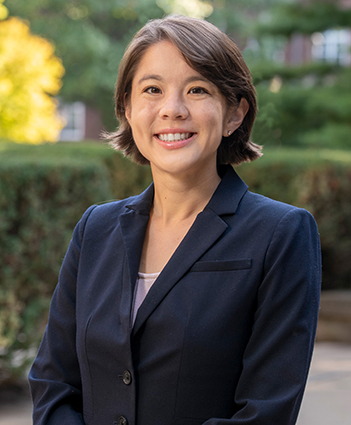Oct 5, 2023
The Plain Truth – The Power of Visual Simplicity
Stroll down the aisles of any grocery store, and you’ll encounter the visual equivalent of a shouting match with countless products demanding your attention. From bold type to bright colors, consumers are constantly bombarded by busy packaging, encouraging them to buy. But is louder always better? Not necessarily, says Gies associate professor Rosanna Smith, whose research indicates there are times when a whisper can be just as good as a shout.

In a recently published article in the Journal of Marketing, Smith, along with her PhD student and colleague at the University of Georgia Terry College of Business, analyzed more than a thousand product packages from the largest supermarket chain in the United States, looking at the quiet brands in a very loud crowd. “We were basically trying to examine under what circumstances people gravitate toward a package that has very little colors or text versus something that’s more complex,” said Smith.
What they discovered was a strong correlation between higher product prices and simple packaging. This indicates that consumers are willing to pay a premium for those products. But the question is why?
According to the study, it could be that simpler packaging prompts consumers to assume that products have fewer ingredients and more purity, both of which appeal to those looking to make healthier food choices. There were, however, exceptions to the rule. Most notably, store brands were less likely to benefit from the effect.
“This is because the simplicity of the product package likely aligns with consumers’ default assumption that store brands invest less in product quality,” said Smith. “Thus, the simplicity of store brand packaging likely signals the lack of investment in the product, rather than positive attributes of few ingredients and product purity.”
Another exception was indulgent foods, like cookies and ice cream. Not everyone enters the grocery store in search of quinoa and granola. When consumers are driven by a desire for products are tasty rather than healthy, research shows the opposite effect. Consumers are more likely to gravitate to — and pay more for — products with more complex packaging design. All of which underscores the importance of understanding your audience when it comes to package design.
Most of us don’t pay much attention to the design of product labels — at least, not consciously. But Smith, who earned a bachelor’s in art from Yale University, has always had a passion for aesthetics in all its various forms.
“I’ve always been very interested in art,” said Smith. “But underlying that interest was an interest in people — understanding relationships and why people were motivated to do what they were going to do, expressed in the medium of paintings, drawings and illustrations.”
After graduation, she began looking for a field of work that would combine both interests. That led to a PhD in marketing at Yale where she studied art and authenticity in a business context. And that’s where Smith finally found her niche.
“A PhD in marketing was ideal, because it allowed me to think through concepts and ideas, and test them in a methodical manner,” said Smith. “But at the same time, there's always the pragmatic question of, ‘how is this relevant to business, to consumers?’” That idea appealed Smith, who wanted her work to be something that could be applied in a concrete way.
For the past six years, Smith has been an assistant professor at the University of Georgia. There she developed a research program that primarily explores how issues related to authenticity intersect with beauty standards, from the shift toward “natural beauty” in cosmetics to Victoria’s Secret’s decision to include “real” body forms in a major marketing rebrand. In the latter, she found that the move significantly boosted the authenticity of the brand, with consumers rewarding body positivity regardless of their own body size.
“Consumers crave authenticity,” said Smith. “They desire a connection with ‘the real,’ but it's quite a challenge to define and measure authenticity.”
That’s something she hopes to do at Gies, where she’ll be teaching brand management and continuing a family tradition. Smith’s parents, who are both psychologists, met during their studies at the University of Illinois. In fact, the psychology department’s reputation was one of the big draws for Smith, who does a lot of work at the intersection of psychology and marketing.
“There’s a very vibrant intellectual environment at Illinois — seminars and interdisciplinary research between the business school and psychology department,” said Smith.
At Gies, she saw many opportunities for collaboration, in a college that was innovative and forward-thinking. “Gies is a place where I can continue to grow as a researcher, thinker, and teacher,” said Smith. It was also closer to family and her partner. And for Smith, that combination provided the perfect package.


